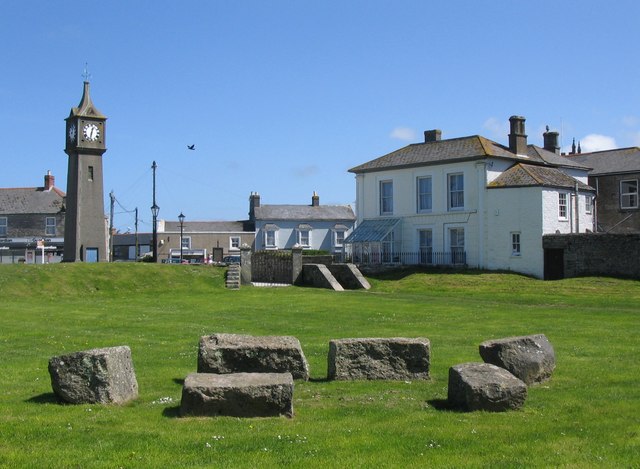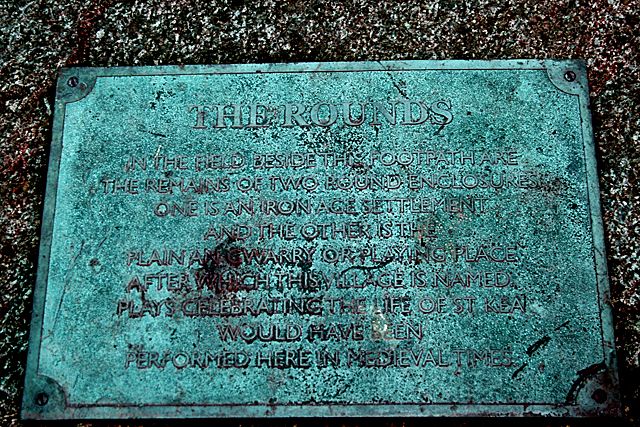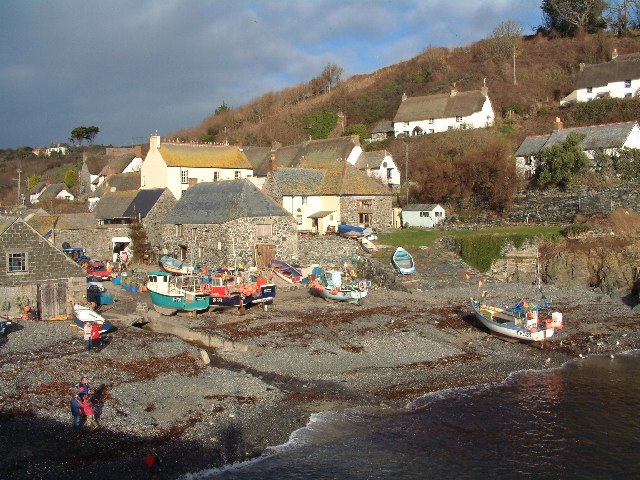|
Plen-an-gwary
A plen-an-gwarry or plain-an-gwary ( kw, Plen an Gwari), is a "playing-place" or round, a medieval amphitheatre found in Cornwall. A circular outdoor space used for plays, sports, and public events, the plen-an-gwary was a Cornish variant of a construction style found across Great Britain. Formerly common across Cornwall, only two survive nearly complete today: the ''Plain'' in St Just in Penwith () and Saint Piran's Round near Perranporth ().''St Just Plain-an-Gwarry''. Historic Cornwall. Retrieved 23 September 2012. The theatre area could be used for local gatherings, sports events, and production of plays. Cornwall culture had a type of play called miracle plays, written in the [...More Info...] [...Related Items...] OR: [Wikipedia] [Google] [Baidu] |
Playing Place
Playing Place is a village southwest of Truro in Cornwall, England, UK. It is to the east of the A39 road.Ordnance Survey ''One-inch Map of Great Britain; Truro and Falmouth, sheet 190''. 1961 The name derives from Cornish ' plain an gwarry' (meaning "playing place"), an open-air performance area used historically for entertainment and instruction. History The village is located in the parish of Kea, and nearby Old Kea is where St Kea landed in Cornwall on the banks of the River Truro. Plays featuring St Kea were particularly performed here amongst other ordinalia according to a plaque in the village. ''Bewnans Ke'' (''The Life of Saint Ke'') is a Middle Cornish Cornish ( Standard Written Form: or ) , is a Southwestern Brittonic language of the Celtic language family. It is a revived language, having become extinct as a living community language in Cornwall at the end of the 18th century. However ... play on the life of the saint, rediscovered in 2000. In more r ... [...More Info...] [...Related Items...] OR: [Wikipedia] [Google] [Baidu] |
Ordinalia
The are three medieval mystery plays dating to the late fourteenth century, written primarily in Middle Cornish, with stage directions in Latin. The three plays are (The Origin of the World, also known as , 2,846 lines), (The Passion of Christ, also known as , 3,242 lines) and (The Resurrection of Our Lord also known as , 2,646 lines). The metres of these plays are various arrangements of seven- and four-syllabled lines. means "prompt" or "service book". (in: ''Oxford Encyclopedia of British Literature'') (in: Koch and Minard edd. ''The Celts'') First play The first play, called , begins with the Creation of the World, the Fall of Man, and Cain and Abel, followed by the building of the Ark and the Flood; the story of the temptation of Abraham closes the first act. The second act gives us the history of Moses, and the third represents the story of David and of the building of Solomon's Temple, curiously ending with a description of the martyrdom of St Maximilla as a Christ ... [...More Info...] [...Related Items...] OR: [Wikipedia] [Google] [Baidu] |
The Green At St Just In Penwith Cornwall
''The'' () is a grammatical article in English, denoting persons or things that are already or about to be mentioned, under discussion, implied or otherwise presumed familiar to listeners, readers, or speakers. It is the definite article in English. ''The'' is the most frequently used word in the English language; studies and analyses of texts have found it to account for seven percent of all printed English-language words. It is derived from gendered articles in Old English which combined in Middle English and now has a single form used with nouns of any gender. The word can be used with both singular and plural nouns, and with a noun that starts with any letter. This is different from many other languages, which have different forms of the definite article for different genders or numbers. Pronunciation In most dialects, "the" is pronounced as (with the voiced dental fricative followed by a schwa) when followed by a consonant sound, and as (homophone of the archaic p ... [...More Info...] [...Related Items...] OR: [Wikipedia] [Google] [Baidu] |
Perranzabuloe
Perranzabuloe (; kw, Pyran yn Treth) is a coastal civil parish and a hamlet in Cornwall, England, United Kingdom. Perranzabuloe parish is bordered to the west by the Atlantic coast and St Agnes parish, to the north by Cubert parish, to the east by St Newlyn East and St Allen parishes and to the south by Kenwyn parish. The hamlet (containing the parish church) is situated just over a mile (2 km) south of the principal settlement of the parish, Perranporth; the hamlet is also seven miles (11 km) south-southwest of Newquay. Other settlements in the parish include Perrancoombe, Goonhavern, Mount and Callestick. The parish population was 5,382 in the 2001 census, increasing to 5,486 at the 2011 census. The name of the parish derives from the medieval Latin ''Perranus in Sabulo'' meaning Piran in the sand. It refers to Saint Piran (the patron saint of Cornwall) who founded an oratory church in the seventh century near the coast north of Perranporth. In medieval ... [...More Info...] [...Related Items...] OR: [Wikipedia] [Google] [Baidu] |
Grade–Ruan
Grade–Ruan is a civil parish on the Lizard peninsula in Cornwall, England, United Kingdom, approximately ten miles (16 km) south of Falmouth. It is a rural parish bounded to the east by St Keverne parish and by the sea; to the west by Mullion and Cury parishes; and to the south by Landewednack parish. Grade–Ruan civil parish encompasses part of Goonhilly Downs and the major settlements are Ruan Minor, St Ruan and Cadgwith. The parish was formed in 1934 because falling population necessitated merging the ecclesiastical parishes of Grade, Ruan Major and Ruan Minor. All three were in the Deanery and Hundred of Kerrier. Formerly, Cadgwith was partly in Grade parish and partly in Ruan Minor parish. The population of Grade–Ruan has increased steadily; it was 677 in 1961, 835 in 1981, 1070 in 2001, and 936 in 2011. There is a school in the parish, Grade Ruan CE Primary School, which is situated in Ruan Minor. Grade–Ruan lies within the Cornwall Area of Outstandin ... [...More Info...] [...Related Items...] OR: [Wikipedia] [Google] [Baidu] |
Marazion
Marazion (; kw, Marhasyow) is a civil parish and town, on the shore of Mount's Bay in Cornwall, UK. It is east of Penzance and the tidal island of St Michael's Mount is half-a-mile offshore. At low water a causeway links it to the town and at high water passenger boats carry visitors between Marazion and St Michael's Mount. Marazion is a tourist resort with an active community of artists who produce and sell paintings and pottery in the town's art galleries. Marazion lies within the Cornwall Area of Outstanding Natural Beauty (AONB). Almost a third of Cornwall has AONB designation, with the same status and protection as a National Park. On the western side of the town is Marazion Marsh, a RSPB reserve and a Site of Special Scientific Interest (SSSI). History of Marazion Remains of an ancient bronze furnace, discovered near the town, tend to prove that tin smelting was practised here at an early period. Marazion was not recorded in the Domesday Book of 1088. Its ... [...More Info...] [...Related Items...] OR: [Wikipedia] [Google] [Baidu] |
Weatherhill, Craig
Craig Weatherhill (1950 or 1951 – 18 or 19 July 2020) was a Cornish antiquarian, novelist and writer on the history, archaeology, place names and mythology of Cornwall. Weatherhill attended school in Falmouth, where his parents ran a sports shop. He played football for a number of local clubs, including Mawnan, and played as goalkeeper for the county football team. Between 1972 and 1974, Weatherhill served with the RAF, training as a cartographer. He was discharged after a serious back injury. He worked as a planning officer, architectural designer and historic conservation expert in local government and private practice. Under the tutelage of historian P.A.S. Pool he conducted archaeological surveys of West Cornwall. Weatherhill was also a Conservation Officer at Penwith District Council. He contributed to the BBC's Radyo Kernow, in particular to the series ''The Tinners' Way'' and ''Beachcombers''. In 1981 Weatherhill was made a Bard of Gorsedh Kernow for services to ... [...More Info...] [...Related Items...] OR: [Wikipedia] [Google] [Baidu] |
Fire Festival
is an annual professional wrestling round-robin tournament held by Pro Wrestling Zero1 to determine the top wrestler in the promotion, typically contested in late July/early August. Within the English-speaking professional wrestling world, the tournament is commonly referred to by its translated name Fire Festival. In addition to Zero1 members, it has frequently included outside stars, including 2003 winner Satoshi Kojima, Kensuke Sasaki and Taka Michinoku. Since 2002, it has featured two blocks, each with five participants, with the two block winners facing off in the final to determine the overall champion. The 2001 Fire Festival only featured four in each block, but held the same principle. The winner of the tournament is presented with the "Fire Sword", which they carry for the following year until the next Festival. Results List of winners 2001 The 2001 Fire Festival was held from September 1 to September 15, over three weekly events on September 1, 8 and 15; fou ... [...More Info...] [...Related Items...] OR: [Wikipedia] [Google] [Baidu] |
Celts
The Celts (, see pronunciation for different usages) or Celtic peoples () are. "CELTS location: Greater Europe time period: Second millennium B.C.E. to present ancestry: Celtic a collection of Indo-European peoples. "The Celts, an ancient Indo-European people, reached the apogee of their influence and territorial expansion during the 4th century bc, extending across the length of Europe from Britain to Asia Minor."; . " e Celts, were Indo-Europeans, a fact that explains a certain compatibility between Celtic, Roman, and Germanic mythology."; . "The Celts and Germans were two Indo-European groups whose civilizations had some common characteristics."; . "Celts and Germans were of course derived from the same Indo-European stock."; . "Celt, also spelled Kelt, Latin Celta, plural Celtae, a member of an early Indo-European people who from the 2nd millennium bce to the 1st century bce spread over much of Europe."; in Europe and Anatolia, identified by their use of Celtic langu ... [...More Info...] [...Related Items...] OR: [Wikipedia] [Google] [Baidu] |
Iron Age
The Iron Age is the final epoch of the three-age division of the prehistory and protohistory of humanity. It was preceded by the Stone Age (Paleolithic, Mesolithic, Neolithic) and the Bronze Age (Chalcolithic). The concept has been mostly applied to Iron Age Europe and the Ancient Near East, but also, by analogy, to other parts of the Old World. The duration of the Iron Age varies depending on the region under consideration. It is defined by archaeological convention. The "Iron Age" begins locally when the production of iron or steel has advanced to the point where iron tools and weapons replace their bronze equivalents in common use. In the Ancient Near East, this transition took place in the wake of the Bronze Age collapse, in the 12th century BC. The technology soon spread throughout the Mediterranean Basin region and to South Asia ( Iron Age in India) between the 12th and 11th century BC. Its further spread to Central Asia, Eastern Europe, and Central Europe is somewhat ... [...More Info...] [...Related Items...] OR: [Wikipedia] [Google] [Baidu] |
Penwith Peninsula
Penwith (; kw, Pennwydh) is an area of Cornwall, England, United Kingdom, located on the peninsula of the same name. It is also the name of a former local government district, whose council was based in Penzance. The area is named after one of the ancient administrative hundreds of Cornwall which derives from two Cornish words, ''penn'' meaning 'headland' and ''wydh'' meaning 'at the end'. Natural England have designated the peninsula as national character area 156 and named it West Penwith. It is also known as the Land's End Peninsula. Geography The Penwith peninsula sits predominantly on granite bedrock that has led to the formation of a rugged coastline with many fine beaches. The contact between the granite and the adjoining sedimentary rock (mostly shales) is most clearly seen forming the cliffs at Land's End, the most westerly point in the district and this geology has resulted in the mining that has made Cornwall famous. Tin and copper have been mined in the ar ... [...More Info...] [...Related Items...] OR: [Wikipedia] [Google] [Baidu] |
Sancreed
Sancreed (''Cornish: Eglossankres'') is a village and civil parish in Cornwall, England, approximately three miles (5 km) west of Penzance. Sancreed civil parish encompasses the settlements of Bejouans, Bosvennen, Botreah, Drift, Sancreed Churchtown, Trenuggo, and Tregonnebris. It is bounded by St Just parish to the west, Madron parish to the northeast, and St Buryan and Paul parishes to the south. The parish comprises of land including Drift Reservoir, which provides drinking water for the area. Geography Sancreed (Cornish: Eglossankres) is an inland parish in the former Hundred of Penwith, about three miles from Penzance. The civil parish encompasses the settlements of Bejouans, Bosvennen, Botreath, Drift, Sancreed Churchtown, Trenuggo and Tregonnebris. It is bounded by St Just to the west, Madron parish to the north-east and St Buryan and Paul parishes to the south. Within the parish is a noteworthy prehistoric settlement at Carn Euny. A few hundred metres ... [...More Info...] [...Related Items...] OR: [Wikipedia] [Google] [Baidu] |



.png)




